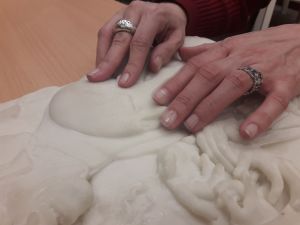



















Cris portraits audio description at the Thyssen- Bornemisza National Museum ( 06/20/2019)/ Audio descripción de retratos de Cris en el museo Thyssen-Bornemisza ( 20/06/2019)
Photographs: Collaborations as a volunteer studing different materials to maje tactile reliefs of paintings in the National Museum Thyssen-Bornemisza (2017-2019)/ Fotos: Colaboraciones como voluntaria estudiando diferentes materiales táctiles para hacer relieves de pinturas en el Museo Nacional Thyssen-Bornemisza 2017-2019
Audio with the conclusions
Blindness and accessible painting: conclusions
From my experiences, I draw three main conclusions:
- A blind person needs minimal means of support to perceive, using the other senses, the aesthetics of a work of art and to create a mental image of it.
- In the case of a two-dimensional work, e.g. a painting, you need to: touch its reproduction in relief, follow an ordered scan and listen to its description.
- There are exhibitions, some of them in museums certified in Universal Accessibility, that do not show any accessible work for people with visual disabilities.
As author of the exhibition «Drawing in Blindness» and student of Tourism and Fine Arts, I consider that a blind person can create an artwork by using their touch, their hearing, their smell and, if they have it, their remaining vision.
Photographs: National Archaeological Museum (Serrano 13, Madrid). There are 18 stands equipped with accessible information and resources for visually-impaired people and a guiding system to help with the same (a handrail as well as a change in the texture of the floor beside the stands). Moreover, they offer tactile visits with the assistance of a museum educator.
Audio con las conclusiones
Ceguera y pintura accesible: conclusiones
De mis vivencias como visitante de exposiciones de arte extraigo tres conclusiones principales:
- Una persona que no puede ver necesita unos medios de apoyo mínimos para percibir, usando los otros sentidos, la estética de una obra de arte y crear su imagen mental de la misma.
- En el caso de una obra bidimensional, p.ej. una pintura, es necesario: tocar su reproducción en relieve, siguiendo una exploración dirigida, al tiempo que escucha la descripción de las imágenes que la componen.
- Hay muchas exposiciones, algunas en museos certificados en Accesibilidad Universal, que no muestran ninguna obra accesible para personas con discapacidad visual.
Como autora de la exposición «Dibujando a Ciegas» y estudiante de Doble Grado en Bellas Artes y Turismo considero que: “ Una persona ciega puede apreciar y crear una obra de arte utilizando el tacto, el oído, el olfato y, en caso de tenerlo, el resto de visión».
